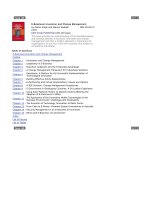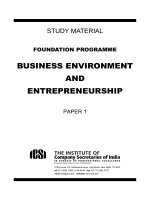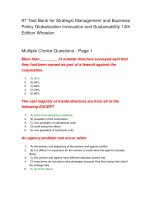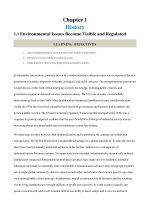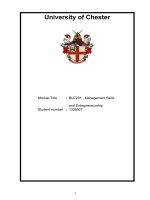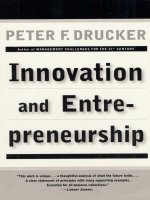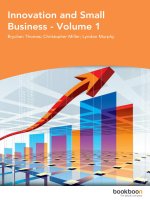INNOVATION AND ENTREPRENEURSHIP
Bạn đang xem bản rút gọn của tài liệu. Xem và tải ngay bản đầy đủ của tài liệu tại đây (845.75 KB, 96 trang )
Entrepreneurship: Successfully Launching New Ventures, 5e (Barringer/Ireland)
Chapter 1 Introduction to Entrepreneurship
1) Pure Fix Cycles, the company profiled in the opening feature of Chapter 1, was launched
by four co-founders and sells ________.
A) fixed gear, single speed bikes
B) entry level bikes that sell in the $100 price range
C) bikes the are durable enough that they almost never need to be fixed
D) high quality bikes that sell in the $1,000+ price range
E) multiple gear, multiple speed bikes
Answer: A
Diff: 1 Page Ref: 3
LO: 1.1: Describe entrepreneurship, corporate entrepreneurship, and the characteristics of
entrepreneurial firms.
AACSB: Reflective Thinking
2) Which of the following is an accurate characterization of interest in entrepreneurship?
A) There is minimal interest in entrepreneurship across the world.
B) There is minimal interest in entrepreneurship in North America and Europe, but significant
interest in Asia and Australia.
C) There is significant interest in entrepreneurship in North America and Europe, but minimal
interest in Asia and Australia.
D) While interest in entrepreneurship was once high, it is waning in popularity across the world.
E) There is tremendous interest in entrepreneurship across the world.
Answer: E
Diff: 1 Page Ref: 3
LO: 1.1: Describe entrepreneurship, corporate entrepreneurship, and the characteristics of
entrepreneurial firms.
AACSB: Application of Knowledge
3) According to the Global Entrepreneurship Monitor (GEM) 2013 survey, about ________
percent of adults in the United States are either starting a business or are running a business that
has been in existence for less than 3 1/2 years.
A) 3.8
B) 5.5
C) 7.6
D) 9.0
E) 12.7
Answer: E
Diff: 3 Page Ref: 5
LO: 1.1: Describe entrepreneurship, corporate entrepreneurship, and the characteristics of
entrepreneurial firms.
AACSB: Application of Knowledge
1
Copyright © 2016 Pearson Education, Inc.
4) According to the Global Entrepreneurship Monitor (GEM) 2013 study, the majority of people
in high-income countries are drawn to entrepreneurship ________.
A) to take advantage of an attractive opportunity
B) due to lack of career prospects
C) as a result of government incentives
D) because an important role model was an entrepreneur
E) to gain prestige
Answer: A
Diff: 2 Page Ref: 5
LO: 1.1: Describe entrepreneurship, corporate entrepreneurship, and the characteristics of
entrepreneurial firms.
AACSB: Reflective Thinking
5) Which of the following statements regarding survival rates of entrepreneurial firms in the
United States is correct?
A) As high as 50 percent after four years
B) As high as 60 percent after four years
C) As high as 70 percent after four years
D) As high as 80 percent after four years
E) As high as 90 percent after four years
Answer: A
Diff: 2 Page Ref: 6
LO: 1.1: Describe entrepreneurship, corporate entrepreneurship, and the characteristics of
entrepreneurial firms.
AACSB: Reflective Thinking
6) Cody Rodgers is the founder of a company named Extreme Sports Apparel. The company
makes apparel products for extreme sports enthusiasts such as rock climbers, triathletes,
skateboarders, and BMX bikers. Cody wants his company to pursue a high level of corporate
entrepreneurship. To achieve that goal, Cody's firm should be ________.
A) innovative, risk averse, and take a "wait and see" posture
B) taking a "wait and see" posture, innovative, and risk taking
C) proactive, not innovative, and risk taking
D) taking a "wait and see" posture, not innovative, and risk averse
E) proactive, innovative, and risk taking
Answer: E
Diff: 2 Page Ref: 6
LO: 1.1: Describe entrepreneurship, corporate entrepreneurship, and the characteristics of
entrepreneurial firms.
AACSB: Analytical Thinking
2
Copyright © 2016 Pearson Education, Inc.
7) Google is a firm that is proactive, innovative and risk-taking. From this description, we can
most accurately conclude that Google has a high level of ________.
A) enterprise focus
B) innovative intensity
C) entrepreneurial intensity
D) creative intensity
E) innovative concentration
Answer: C
Diff: 2 Page Ref: 7
LO: 1.1: Describe entrepreneurship, corporate entrepreneurship, and the characteristics of
entrepreneurial firms.
AACSB: Reflective Thinking
8) Apple is an established firm that encourages and emphasizes entrepreneurial behavior
throughout its various divisions. According to the textbook, Apple practices ________
entrepreneurship.
A) tactical
B) corporate
C) strategic
D) business
E) enterprise
Answer: B
Diff: 2 Page Ref: 7
LO: 1.1: Describe entrepreneurship, corporate entrepreneurship, and the characteristics of
entrepreneurial firms.
AACSB: Reflective Thinking
9) According to the opening feature on Pure Fix Cycles, one of the biggest challenges the startup
now faces is an increasingly competitive marketplace.
Answer: TRUE
Diff: 1 Page Ref: 3
LO: 1.1: Describe entrepreneurship, corporate entrepreneurship, and the characteristics of
entrepreneurial firms.
AACSB: Reflective Thinking
10) According to the results of the GEM 2013 survey, about 1 out of every 8 American adults is
actively engaged in starting a business or is the owner/manager of a business that is less than 3
1/2 years old.
Answer: TRUE
Diff: 2 Page Ref: 5
LO: 1.1: Describe entrepreneurship, corporate entrepreneurship, and the characteristics of
entrepreneurial firms.
AACSB: Application of Knowledge
3
Copyright © 2016 Pearson Education, Inc.
11) According to reliable statistics, 9 out of 10 businesses fail in their first few years of
existence.
Answer: FALSE
Diff: 2 Page Ref: 5
LO: 1.1: Describe entrepreneurship, corporate entrepreneurship, and the characteristics of
entrepreneurial firms.
AACSB: Reflective Thinking
12) Entrepreneurship is the process by which individuals pursue opportunities within the
constraints of the resources they control.
Answer: FALSE
Diff: 1 Page Ref: 6
LO: 1.1: Describe entrepreneurship, corporate entrepreneurship, and the characteristics of
entrepreneurial firms.
AACSB: Reflective Thinking
13) Established firms with an entrepreneurial emphasis are proactive, innovative, and risk-taking.
Answer: TRUE
Diff: 2 Page Ref: 7
LO: 1.1: Describe entrepreneurship, corporate entrepreneurship, and the characteristics of
entrepreneurial firms.
AACSB: Analytical Thinking
14) What is entrepreneurship? What is the essence of entrepreneurial behavior?
Answer: Entrepreneurship is the process by which individuals pursue opportunities without
regard to the resources they currently control. The essence of entrepreneurial behavior is
identifying opportunities and putting useful ideas into practice.
Diff: 1 Page Ref: 6
LO: 1.1: Describe entrepreneurship, corporate entrepreneurship, and the characteristics of
entrepreneurial firms.
AACSB: Reflective Thinking
15) Describe the three primary reasons that people become entrepreneurs and start their own
firms.
Answer: The three primary reasons that people become entrepreneurs and start their own firms
are to (1) be their own boss, (2) pursue their own ideas, and (3) realize financial rewards.
The first of these reasons-being one's own boss-is given most commonly. Many entrepreneurs
want to be their own boss because either they have had a long-time ambition to own their own
firm or they have become frustrated working in traditional jobs. The second reason people start
their own firms is to pursue their own ideas. Some people are naturally alert, and when they
recognize ideas for new products or services, they have a desire to see those ideas realized. The
third reason people start their own firms is to pursue financial rewards. This motivation, however,
is typically secondary to the first two.
Diff: 2 Page Ref: 7
LO: 1.1: Describe entrepreneurship, corporate entrepreneurship, and the characteristics of
entrepreneurial firms.
AACSB: Reflective Thinking
4
Copyright © 2016 Pearson Education, Inc.
16) The three primary reasons that people become entrepreneurs and start their own firms are to
________.
A) gain prestige, realize financial rewards, and eliminate risk in their lives
B) do what they were "born" to do, be their own boss, and gain prestige
C) take big risks, be their own boss, and do what they were "born" to do
D) be their own boss, pursue their own ideas, and realize financial rewards
E) take advantage of government subsidies, pursue their own ideas, and realize financial rewards
Answer: D
Diff: 2 Page Ref: 7
LO: 1.2: Discuss three main reasons people decide to become entrepreneurs.
AACSB: Reflective Thinking
17) According to the textbook, the number one reason that people become entrepreneurs is to
________.
A) realize financial rewards
B) gain prestige
C) be their own boss
D) continue a family tradition
E) pursue their own ideas
Answer: C
Diff: 1 Page Ref: 7
LO: 1.2: Discuss three main reasons people decide to become entrepreneurs.
AACSB: Reflective Thinking
18) Kasey Stevenson is starting a firm in the women's clothing industry primarily to pursue
financial rewards. According to the textbook, starting a business to make a lot of money
________.
A) often fails to live up to its hype
B) is equally as satisfying as other reasons for starting a business
C) is the number one reason people start their own business
D) is the number two reason that people start their own business, right behind the lack of better
career prospects
E) does not rank among the top three reasons that people start their own business
Answer: A
Diff: 2 Page Ref: 8
LO: 1.2: Discuss three main reasons people decide to become entrepreneurs.
AACSB: Reflective Thinking
19) The number one reason that people become entrepreneurs is to pursue financial rewards.
Answer: FALSE
Diff: 2 Page Ref: 7
LO: 1.2: Discuss three main reasons people decide to become entrepreneurs.
AACSB: Reflective Thinking
5
Copyright © 2016 Pearson Education, Inc.
20) According to the textbook, the four characteristics of successful entrepreneurs are ________.
A) passion for the business, on the cutting edge of technological change, very charismatic, and
tenacity despite failure
B) young and energetic, passion for the business, product/customer focus, and seeks recognition
C) passion for the business, tenacity despite failure, product/customer focus, and execution
intelligence
D) on the cutting edge of technological change, forward thinking, tenacity despite failure, and
product/customer focus
E) passion for the business, seeks recognition, young and energetic, and execution intelligence
Answer: C
Diff: 2 Page Ref: 9
LO: 1.3: Identify four main characteristics of successful entrepreneurs.
AACSB: Reflective Thinking
21) The number one characteristic shared by successful entrepreneurs is ________.
A) a desire to achieve financial rewards
B) a passion for the business
C) a desire to employ other people
D) a desire to fulfill a lifetime dream
E) a desire to bring a revolutionary new product or service to market
Answer: B
Diff: 2 Page Ref: 9
LO: 1.3: Identify four main characteristics of successful entrepreneurs.
AACSB: Reflective Thinking
22) According to the textbook, the passion that motivates people to launch entrepreneurial firms
typically stems from the entrepreneur's belief that the business will ________.
A) positively influence people's lives
B) make a lot of money
C) increase his or her prestige
D) lead to a high-level job in the corporate sector
E) provide for a secure retirement
Answer: A
Diff: 2 Page Ref: 9
LO: 1.3: Identify four main characteristics of successful entrepreneurs.
AACSB: Reflective Thinking
6
Copyright © 2016 Pearson Education, Inc.
23) Which of the following was not identified in the textbook as one of the five primary reasons
passion is important for the launch of a successful entrepreneurial organization?
A) The ability to stick to a plan even when faced with evidence that changes are needed
B) A willingness to work hard for an extended period of time
C) The ability to overcome setbacks and "no's"
D) The ability to listen to feedback on the limitations of your organization and yourself
E) The ability to learn and iterate.
Answer: A
Diff: 3 Page Ref: 10
LO: 1.3: Identify four main characteristics of successful entrepreneurs.
AACSB: Analytical Thinking
24) The What Went Wrong? feature in Chapter 1 focuses on Prim, a failed startup in the laundry
industry. According to the feature, Prim failed largely as a result of ________.
A) lack of product/customer focus
B) poor intellectual property protection
C) the individuals who started the firm were too young and inexperienced
D) poor execution intelligence
E) a lack of passion and resolve
Answer: E
Diff: 2 Page Ref: 11
LO: 1.3: Identify four main characteristics of successful entrepreneurs.
AACSB: Reflective Thinking
25) Stacey Wills, who is at heart a craftsperson, recently started a firm to manufacturer a new
innovative food blender. Stacey's desire is to sell her food blender to as many people as possible
because she firmly believes in the merits of her product. Stacey's story best illustrates which of
the following characteristics, or attributes, of a successful entrepreneur?
A) Product/customer focus
B) Execution intelligence
C) Tenacity despite failure
D) A desire to please consumers
E) A desire to gain financial rewards
Answer: A
Diff: 1 Page Ref: 12
LO: 1.3: Identify four main characteristics of successful entrepreneurs.
AACSB: Analytical Thinking
7
Copyright © 2016 Pearson Education, Inc.
26) Alex and Patty Webb launched a firm several years ago and have been particularly
successful in introducing new products to the marketplace. One thing that Alex and Patty are
particularly good at is translating their thoughts, creativity, and imaginations into products that
reach the marketplace. The ability to make this happen is most closely related to which of the
following characteristics of successful entrepreneurs?
A) A passion for the business
B) Execution intelligence
C) Tenacity despite failure
D) Product/market focus
E) A desire for recognition
Answer: B
Diff: 2 Page Ref: 13
LO: 1.3: Identify four main characteristics of successful entrepreneurs.
AACSB: Reflective Thinking
27) The Savvy Entrepreneurial Firm feature in Chapter 1 focuses on Pandora, the Internet
streaming music company. The feature's main purpose is to illustrate the importance of
________ as a key characteristic of the founders and employees of entrepreneurial firms.
A) execution intelligence
B) a desire to pursue financial rewards
C) tenacity despite failure
D) passion for the business
E) product/customer focus
Answer: C
Diff: 3 Page Ref: 14
LO: 1.3: Identify four main characteristics of successful entrepreneurs.
AACSB: Analytical Thinking
28) The number one characteristic shared by successful entrepreneurs is passion for the business.
Answer: TRUE
Diff: 1 Page Ref: 9
LO: 1.3: Identify four main characteristics of successful entrepreneurs.
AACSB: Reflective Thinking
29) The four main characteristics of successful entrepreneurs are: passion for the business,
execution intelligence, product/customer focus, and tenacity despite failure.
Answer: TRUE
Diff: 2 Page Ref: 9
LO: 1.3: Identify four main characteristics of successful entrepreneurs.
AACSB: Reflective Thinking
30) The passion that entrepreneurs have typically stems from the ability to pursue their own
ideas.
Answer: FALSE
Diff: 3 Page Ref: 9
LO: 1.3: Identify four main characteristics of successful entrepreneurs.
AACSB: Reflective Thinking
8
Copyright © 2016 Pearson Education, Inc.
31) Describe the four main characteristics of successful entrepreneurs.
Answer: The four main characteristics of successful entrepreneurs are: passion for the business,
product/customer focus, tenacity despite failure, and execution intelligence. The number one
characteristic shared by successful entrepreneurs is passion for their business, whether it is in the
context of a new firm or an existing business. This passion typically stems from the
entrepreneur's belief that the business will positively influence people's lives. A second defining
characteristic of successful entrepreneurs is a product/customer focus. This characteristic
underscores two of the most important elements in any business-products and customers. The
third characteristic of successful entrepreneurs is tenacity despite failure. Because entrepreneurs
are typically trying something new, the failure rate associated with their efforts is naturally high.
The litmus test for entrepreneurs is their ability to persevere through setbacks and failures. The
fourth characteristic of successful entrepreneurs is execution intelligence. The ability to
effectively execute a business idea means developing a business model, putting together a new
venture team, raising money, establishing partnerships, managing finances, leading and
motivating employees, and so on.
Diff: 2 Page Ref: 9
LO: 1.3: Identify four main characteristics of successful entrepreneurs.
AACSB: Reflective Thinking
32) Which of the following is not one of the five common myths about entrepreneurs?
A) Entrepreneurs are tenacious.
B) Entrepreneurs are moderate risk takers.
C) Entrepreneurs should be young and energetic.
D) Entrepreneurs love the spotlight.
E) Entrepreneurs are born not made.
Answer: A
Diff: 2 Page Ref: 14
LO: 1.4: Explain five common myths regarding entrepreneurship.
AACSB: Reflective Thinking
33) According to the textbook, entrepreneurs are ________.
A) gamblers
B) moderate risk takers
C) aggressive risk takers
D) forceful risk takers
E) minimal risk takers
Answer: B
Diff: 2 Page Ref: 15
LO: 1.4: Explain five common myths regarding entrepreneurship.
AACSB: Reflective Thinking
9
Copyright © 2016 Pearson Education, Inc.
34) Which of the following was not identified in the textbook as one of the common traits and
characteristics of entrepreneurs?
A) Lengthy attention span
B) Self-starter
C) Tolerant of ambiguity
D) Tenacious
E) Pessimistic disposition
Answer: E
Diff: 3 Page Ref: 16
LO: 1.4: Explain five common myths regarding entrepreneurship.
AACSB: Reflective Thinking
35) Suppose you are a Small Business Development Center counselor and you're looking at the
personality profiles of five potential entrepreneurs. Based on the profiles, which individual has
the most desirable mix of personal characteristics to become a successful entrepreneur?
A) Candidate A: visionary, energetic, moderate risk taker
B) Candidate B: seeks recognition, self-starter, creative
C) Candidate C: visionary, high-risk taker, energetic
D) Candidate D: high-risk taker, achievement-motivated, networker
E) Candidate E: tolerant for ambiguity, seeks recognition, motivated primarily by money
Answer: A
Diff: 3 Page Ref: 16
LO: 1.4: Explain five common myths regarding entrepreneurship.
AACSB: Reflective Thinking
36) Which of the following is not a personality trait or characteristic common among
entrepreneurs?
A) Promoter
B) Visionary
C) Short attention span
D) Alert to opportunities
E) Self-starter
Answer: C
Diff: 3 Page Ref: 16
LO: 1.4: Explain five common myths regarding entrepreneurship.
AACSB: Reflective Thinking
10
Copyright © 2016 Pearson Education, Inc.
37) Which of the following statements is correct regarding entrepreneurial activity and age
ranges?
A) The highest percentage of entrepreneurs falls in the 18 to 29 age range.
B) The highest percentage of entrepreneurs falls in the 30 to 39 age range.
C) The highest percentage of entrepreneurs falls in the 40 to 49 age range.
D) The highest percentage of entrepreneurs falls in the 50 to 59 age range.
E) The highest percentage of entrepreneurs falls in the 60+ age range.
Answer: B
Diff: 2 Page Ref: 17
LO: 1.4: Explain five common myths regarding entrepreneurship.
AACSB: Application of Knowledge
38) Which of the following statements is incorrect regarding entrepreneurial activity and age
range?
A) The highest percent of business owners fall in the 30-39 age range.
B) The lowest percent of business owners fall in the 60+ age rage.
C) The majority of business founders have no prior work experience.
D) The majority of individuals who start companies are in their thirties and forties.
E) Entrepreneurial activity is fairly evenly spread out over age ranges.
Answer: C
Diff: 2 Page Ref: 17
LO: 1.4: Explain five common myths regarding entrepreneurship.
AACSB: Analytical Thinking
39) According to Chapter 1, investors often cite the ________ as their most important criterion in
the decision to fund new ventures.
A) financial position of the new venture
B) strength of the industry the new firm is entering
C) strength of the new venture's marketing plan
D) strength of the business idea
E) strength of the entrepreneur
Answer: E
Diff: 2 Page Ref: 17
LO: 1.4: Explain five common myths regarding entrepreneurship.
AACSB: Reflective Thinking
11
Copyright © 2016 Pearson Education, Inc.
40) According to Chapter 1, a sentiment that venture capitalists often express is that ________.
A) the strength of the entrepreneur and the strength of the business idea are of equal importance
B) they would never fund a strong entrepreneur with a weak business idea
C) they would rather fund a strong entrepreneur with a mediocre business idea than fund a strong
business idea with a mediocre entrepreneur
D) a new venture's marketing plan is more important than either the strength of the entrepreneur
or the strength of the business idea
E) they would rather fund a strong business idea with a mediocre entrepreneur than fund a strong
entrepreneur with a mediocre business idea
Answer: C
Diff: 3 Page Ref: 17
LO: 1.4: Explain five common myths regarding entrepreneurship.
AACSB: Analytical Thinking
41) Pacific Fishing LLC is a startup that is working on a new technology for the fishing industry.
Because the technology it's working on is highly proprietary, the company is located in the
warehouse district of a large western city. Pacific's founder, Ray Sims, rarely gives interviews
and is careful to not divulge much about what the company is doing. Which of the following
common myths about entrepreneurs does the behavior of its founder, Ray Sims, dispel?
A) Entrepreneurs are born, not made.
B) Entrepreneurs are gamblers.
C) Entrepreneurs are motivated primarily by money.
D) Entrepreneurs should be young and energetic.
E) Entrepreneurs love the spotlight.
Answer: E
Diff: 2 Page Ref: 17
LO: 1.4: Explain five common myths regarding entrepreneurship.
AACSB: Reflective Thinking
42) According to the consensus of the research, some people are genetically predisposed to be
entrepreneurs.
Answer: FALSE
Diff: 2 Page Ref: 15
LO: 1.4: Explain five common myths regarding entrepreneurship.
AACSB: Analytical Thinking
43) Entrepreneurs are usually moderate, rather than high, risk-takers.
Answer: TRUE
Diff: 3 Page Ref: 15
LO: 1.4: Explain five common myths regarding entrepreneurship.
AACSB: Reflective Thinking
44) Entrepreneurs are motivated primarily by money.
Answer: FALSE
Diff: 2 Page Ref: 16
LO: 1.4: Explain five common myths regarding entrepreneurship.
AACSB: Reflective Thinking
12
Copyright © 2016 Pearson Education, Inc.
45) According to the textbook, there are three types of startup firms: ________.
A) lifestyle firms, general firms, and entrepreneurial firms
B) standard-of-living firms, statutory firms, and general firms
C) entrepreneurial firms, standard-of-living firms, and statutory firms
D) lifestyle firms, salary-substitute firms, and entrepreneurial firms
E) innovative firms, entrepreneurial firms, and standard firms
Answer: D
Diff: 2 Page Ref: 18
LO: 1.5: Describe the three types of start-up firms.
AACSB: Reflective Thinking
46) Colorado Sandwich, Soup and Salad is a casual dining restaurant that has been owned by
Stephanie Peterson for the past 14 years. The restaurant offers a menu that is typical for casual
dining restaurants and affords Stephanie a level of income that is similar to what she would earn
in a conventional job. According to the textbook, Colorado Sandwich, Soup and Salad is an
example of a(n) ________ firm.
A) salary-substitute
B) entrepreneurial
C) quality-of-life
D) lifestyle
E) industry-standard
Answer: A
Diff: 2 Page Ref: 18
LO: 1.5: Describe the three types of start-up firms.
AACSB: Reflective Thinking
47) Montana Sky Trails leads multiday outdoor adventure trips for private groups and corporate
clients to various locations across Montana. The company was started by Justin Smith, an
individual that gave up a prestigious job in banking because Montana Sky Trails better
accommodates his personal lifestyle. Montana Sky Trails is an example of a(n) ________ firm.
A) entrepreneurial
B) salary-substitute
C) standard-of-living
D) statutory
E) lifestyle
Answer: E
Diff: 1 Page Ref: 18
LO: 1.5: Describe the three types of start-up firms.
AACSB: Reflective Thinking
13
Copyright © 2016 Pearson Education, Inc.
48) Entrepreneurial firms ________.
A) are small firms that yield a level of income for their owner(s) that is similar to what they
would earn when working for an employer
B) bring to market new products and services that are not particularly innovative
C) offer to customers common products that are not particularly innovative, and provide their
owner(s) the opportunity to pursue a particular lifestyle and earn a living while doing so
D) provide their owner(s) the opportunity to pursue a particular lifestyle and earn a living while
doing so
E) bring new products and services to market by creating and seizing opportunities
Answer: E
Diff: 2 Page Ref: 18
LO: 1.5: Describe the three types of start-up firms.
AACSB: Analytical Thinking
49) According to the textbook, Dropbox, Facebook, and LinkedIn are examples of ________
firms.
A) lifestyle
B) salary-substitute
C) industry-standard
D) entrepreneurial
E) standard-of-living
Answer: D
Diff: 1 Page Ref: 18
LO: 1.5: Describe the three types of start-up firms.
AACSB: Reflective Thinking
50) The Partnering for Success feature in Chapter 1 focuses on start-up incubators and
accelerators. According to the feature, participating in a start-up incubator or accelerator is an
excellent way to ________.
A) learn how to write a business plan
B) prepare to become a franchisor
C) gain access to mentors, partners and investors
D) learn how to conduct an industry analysis
E) prepare for a job in a major corporation
Answer: C
Diff: 2 Page Ref: 19
LO: 1.5: Describe the three types of start-up firms.
AACSB: Reflective Thinking
51) In terms of the "types" of startup firms, entrepreneurial firms bring new products and
services to market.
Answer: TRUE
Diff: 1 Page Ref: 18
LO: 1.5: Describe the three types of start-up firms.
AACSB: Analytical Thinking
14
Copyright © 2016 Pearson Education, Inc.
52) Identify the three types of startup firms, and discuss how they differ. Provide examples of
each type of firm.
Answer: The three types of startup firms are: salary-substitute firms, lifestyle firms, and
entrepreneurial firms. Salary-substitute firms are small firms that afford their owners a level of
income similar to what they would earn in a conventional job. Examples of salary-substitute
firms are dry cleaners, convenience stores, restaurants, accounting firms, retail stores, and
hairstyling salons. Lifestyle firms provide their owner or owners the opportunity to pursue a
particular lifestyle and earn a living while doing so. Examples of lifestyle firms include ski
instructors, golf pros, and tour guides. Entrepreneurial firms bring new products and services to
market by creating and seizing opportunities. There are many examples of entrepreneurial firms
in computer software, biotechnology, and medical devices.
Diff: 2 Page Ref: 18
LO: 1.5: Describe the three types of start-up firms.
AACSB: Reflective Thinking
53) Which of the following statements is not true about women-owned businesses in the United
States?
A) The number of women-owned businesses is decreasing.
B) A total of 33 percent of women-owned businesses are owned by minorities.
C) In some industries, women own a significant share of the business.
D) The number of groups that support and advocate for women-owned businesses continues to
increase.
E) Between 1997 and 2013, the number of women-owned businesses increased at a rate of
one-and-a-half times the national average.
Answer: A
Diff: 2 Page Ref: 20
LO: 1.6: Discuss the changing demographics of entrepreneurs in the United States.
AACSB: Reflective Thinking
54) There has been ________ in the number of minority entrepreneurs in the United States over
the past several years.
A) a moderate increase
B) a substantial decrease
C) no meaningful change
D) a substantial increase
E) a moderate decrease
Answer: D
Diff: 2 Page Ref: 21
LO: 1.6: Discuss the changing demographics of entrepreneurs in the United States.
AACSB: Reflective Thinking
15
Copyright © 2016 Pearson Education, Inc.
55) Which of the following was not given in the textbook as a reason for the increase in the
number of senior entrepreneurs?
A) Seniors tend to be more passionate about new business ideas than middle-aged or younger
prospective entrepreneurs.
B) Many seniors have extensive business experience and other qualities that equip them for an
entrepreneurial career.
C) Growing worries among seniors that they need to earn additional income to pay for future
health care services and other expenses
D) An increasing desire among older workers for more personal fulfillment in their lives
E) Corporate downsizing
Answer: A
Diff: 2 Page Ref: 21
LO: 1.6: Discuss the changing demographics of entrepreneurs in the United States.
AACSB: Reflective Thinking
56) According to a recent Gallop survey, about ________ percent of kids in grades 5-12 say they
plan to start their own business.
A) 10
B) 20
C) 30
D) 40
E) 50
Answer: D
Diff: 3 Page Ref: 21
LO: 1.6: Discuss the changing demographics of entrepreneurs in the United States.
AACSB: Reflective Thinking
57) Over the past 10 years, the demographic makeup of entrepreneurial firms has remained fairly
stable in the United States and around the world.
Answer: FALSE
Diff: 2 Page Ref: 20
LO: 1.6: Discuss the changing demographics of entrepreneurs in the United States.
AACSB: Reflective Thinking
58) Although interest in entrepreneurship remains high nationwide, the number of women-owned
businesses is decreasing.
Answer: FALSE
Diff: 2 Page Ref: 20
LO: 1.6: Discuss the changing demographics of entrepreneurs in the United States.
AACSB: Application of Knowledge
59) Unfortunately, statistics show that there is very little interest in entrepreneurship among
young people in the United States.
Answer: FALSE
Diff: 2 Page Ref: 21
LO: 1.6: Discuss the changing demographics of entrepreneurs in the United States.
AACSB: Reflective Thinking
16
Copyright © 2016 Pearson Education, Inc.
60) As new products that are better than the existing generation of products are introduced, sales
normally increase because the new products provide consumers increased value or worth. This
process, which is called ________, stimulates economic activity, which is a good thing for the
economy.
A) creative destruction
B) repetitive destruction
C) iterative replacement
D) inventive replacement
E) iterative destruction
Answer: A
Diff: 2 Page Ref: 22
LO: 1.7: Discuss the positive effects of entrepreneurship and entrepreneurial firms on economies
and societies.
AACSB: Analytical Thinking
61) In the book The Theory of Economic Development, ________ argued that entrepreneurs
develop new products and technologies that, over time, make current products and technologies
obsolete. This process is called creative destruction.
A) Malcolm Gladwell
B) Seth Godin
C) Joseph Schumpeter
D) Thomas Friedman
E) Jim Collins
Answer: C
Diff: 2 Page Ref: 22
LO: 1.7: Discuss the positive effects of entrepreneurship and entrepreneurial firms on economies
and societies.
AACSB: Reflective Thinking
62) According to the textbook, entrepreneurship has historically had ________.
A) a major impact on the economy and minor impact on society
B) a minor impact on both the economy and society
C) a major impact on society and minor impact on the economy
D) a major impact on both the economy and society
E) no impact on either the economy or society
Answer: D
Diff: 1 Page Ref: 22
LO: 1.7: Discuss the positive effects of entrepreneurship and entrepreneurial firms on economies
and societies.
AACSB: Reflective Thinking
17
Copyright © 2016 Pearson Education, Inc.
63) ________ is the process of creating something new, which is central to the entrepreneurial
process.
A) Creative destruction
B) Modernism
C) Execution
D) Creativity
E) Innovation
Answer: E
Diff: 1 Page Ref: 24
LO: 1.7: Discuss the positive effects of entrepreneurship and entrepreneurial firms on economies
and societies.
AACSB: Reflective Thinking
64) In regard to patent activity (issuance), which of the following statements is correct?
A) Small businesses outperform their larger counterparts.
B) Small businesses underperform their larger counterparts.
C) Small businesses and large businesses are relatively equal.
D) Small businesses are not active in patent activity.
E) Large businesses are not active in patent activity.
Answer: A
Diff: 2 Page Ref: 24
LO: 1.7: Discuss the positive effects of entrepreneurship and entrepreneurial firms on economies
and societies.
AACSB: Reflective Thinking
65) Joseph Schumpeter argued that entrepreneurs develop new products and technologies that
over time make current products and technologies obsolete, and this process, which he called
creative destruction, is good because it stimulates economic activity.
Answer: TRUE
Diff: 2 Page Ref: 22
LO: 1.7: Discuss the positive effects of entrepreneurship and entrepreneurial firms on economies
and societies.
AACSB: Reflective Thinking
66) Innovation is the process of creating something new, which is central to the entrepreneurial
process.
Answer: TRUE
Diff: 1 Page Ref: 24
LO: 1.7: Discuss the positive effects of entrepreneurship and entrepreneurial firms on economies
and societies.
AACSB: Reflective Thinking
18
Copyright © 2016 Pearson Education, Inc.
67) Small businesses outperform their larger counterparts in terms of patent activity (issuance).
Answer: TRUE
Diff: 3 Page Ref: 24
LO: 1.7: Discuss the positive effects of entrepreneurship and entrepreneurial firms on economies
and societies.
AACSB: Reflective Thinking
68) Identify and discuss the three primary reasons that entrepreneurial behavior has a strong
impact on the United States economy.
Answer: The two reasons that entrepreneurial behavior has a strong impact on the United States
economy are as follows: innovation and job creation. Innovation is the process of creating
something new, which is central to the entrepreneurial process. According to the Small Business
Administration (SBA) Office of Advocacy, small innovative firms are 16 times more productive
than large innovative firms in terms of patents per employee. In regard to job creation, according
to the SBA, small businesses create a substantial number of new jobs in the United States. Firms
with 500 or fewer employees create 65 percent of new jobs on an annual basis.
Diff: 3 Page Ref: 24
LO: 1.7: Discuss the positive effects of entrepreneurship and entrepreneurial firms on economies
and societies.
AACSB: Reflective Thinking
69) Which of the following is the correct sequence for the four steps in the entrepreneurial
process?
A) Deciding to become an entrepreneur, developing successful business ideas, moving from an
idea to an entrepreneurial firm, managing the growing entrepreneurial firm
B) Developing successful business ideas, deciding to become an entrepreneur, moving from an
idea to an entrepreneurial firm, managing and growing the entrepreneurial firm
C) Developing successful business ideas, moving from an idea to an entrepreneurial firm,
deciding to become an entrepreneur, managing and growing the entrepreneurial firm
D) Deciding to become an entrepreneur, moving from an idea to an entrepreneurial firm,
developing successful business ideas, managing and growing the entrepreneurial firm
E) Managing and growing the entrepreneurial firm, developing successful business ideas,
deciding to become an entrepreneur, moving from an idea to an entrepreneurial firm
Answer: A
Diff: 3 Page Ref: 25
LO: 1.8: Explain the entrepreneurial process.
AACSB: Reflective Thinking
19
Copyright © 2016 Pearson Education, Inc.
70) Which of the following is not one of the four steps of the entrepreneurial process?
A) Deciding to become an entrepreneur
B) Determining how to seize the spotlight
C) Developing successful business ideas
D) Moving from an idea to an entrepreneurial firm
E) Managing and growing the entrepreneurial firm
Answer: B
Diff: 1 Page Ref: 25
LO: 1.8: Explain the entrepreneurial process.
AACSB: Reflective Thinking
71) An event that prompts an individual to become an entrepreneur, such as losing a job,
inheriting money, or accommodating a certain lifestyle, is referred to as a(n) ________.
A) prompting event
B) entrepreneurial prompt
C) initiating event
D) triggering event
E) kick-off event
Answer: D
Diff: 1 Page Ref: 25
LO: 1.8: Explain the entrepreneurial process.
AACSB: Reflective Thinking
72) Jan Berry recently received a $500,000 inheritance from her maternal grandmother. Jan
decided to use the money to start a business. According to the textbook, the inheritance that Jan
received was the ________ that prompted her to start a business.
A) prompting event
B) entrepreneurial prompt
C) initiating event
D) triggering event
E) kick-off event
Answer: D
Diff: 1 Page Ref: 25
LO: 1.8: Explain the entrepreneurial process.
AACSB: Reflective Thinking
73) A(n) ________ is a written document that describes all the aspects of a business venture in a
concise manner.
A) business plan
B) business model
C) operations plan
D) corporate plan
E) contingency plan
Answer: A
Diff: 1 Page Ref: 25
LO: 1.8: Explain the entrepreneurial process.
AACSB: Reflective Thinking
20
Copyright © 2016 Pearson Education, Inc.
74) A firm's ________ is a plan for how it competes, uses its resources, structures its
relationships, interfaces with customers, and creates value to sustain itself on the basis of the
value it creates.
A) business plan
B) business model
C) tactical model
D) strategic plan
E) operations model
Answer: B
Diff: 2 Page Ref: 25
LO: 1.8: Explain the entrepreneurial process.
AACSB: Reflective Thinking
75) The entrepreneurial process consists of four steps: deciding to become an entrepreneur,
developing successful business ideas, moving from an idea to an entrepreneurial firm, and
divesting or selling the entrepreneurial firm.
Answer: FALSE
Diff: 2 Page Ref: 23
LO: 1.8: Explain the entrepreneurial process.
AACSB: Reflective Thinking
21
Copyright © 2016 Pearson Education, Inc.
Entrepreneurship: Successfully Launching New Ventures, 6e (Barringer/Ireland)
Chapter 2 Recognizing Opportunities and Generating Ideas
1) Wiivv, the company profiled in the opening feature of Chapter 2, is in the 3D printing
business of footwear insoles. To manufacture the insoles, the company uses a process called
________ manufacturing.
A) structured
B) adhesive
C) bounded
D) batch
E) adaptive
Answer: E
Diff: 2
LO: 2.1: Explain the difference between opportunities and ideas.
AACSB: Analytical Thinking
Quest. Category: Critical Thinking
2) A(n) ________ is a favorable set of circumstances that creates a need for a new product,
service, or business.
A) idea
B) scheme
C) design
D) proposal
E) opportunity
Answer: E
Diff: 1
LO: 2.1: Explain the difference between opportunities and ideas.
AACSB: Reflective Thinking
Quest. Category: Analytical
3) According to the textbook, opportunities are ________.
A) easy to spot
B) easy to spot in fast growing industries, but tough to spot in slow growing industries
C) easy to spot in the manufacturing sector, but tough to spot in the service sector
D) tough to spot
E) neither easy nor tough to spot
Answer: D
Diff: 2
LO: 2.1: Explain the difference between opportunities and ideas.
AACSB: Reflective Thinking
Quest. Category: Critical Thinking
1
Copyright © 2019 Pearson Education, Inc.
4) An opportunity has the following four essential qualities: ________.
A) attractive; timely; durable; and anchored in a product, service, or business that creates or adds
value for its buyer or end user
B) practical; opportune; appropriate; and anchored in a product, service, or business that is
efficient and effective
C) realistic; striking; timely; and anchored in a product, service, or business that is timely
D) attention-getting; attractive; timely; and anchored in a product, service, or business that
creates or adds value for its buyer or end user
E) attractive, durable, resilient, and opportune
Answer: A
Diff: 2
LO: 2.1: Explain the difference between opportunities and ideas.
AACSB: Reflective Thinking
Quest. Category: Critical Thinking
5) Brad Johnson is starting an upscale men's clothing store in a mall near Seattle. He wants to
open his store during the time period in which a business like his can realistically enter the new
market. Brad is trying to open his business while the ________ is open.
A) safe harbor
B) window of opportunity
C) portal of entry
D) doorway of opportunity
E) safety zone
Answer: B
Diff: 2
LO: 2.1: Explain the difference between opportunities and ideas.
AACSB: Reflective Thinking
Quest. Category: Critical Thinking
6) The term "window of opportunity," as discussed in Chapter 2, is a metaphor that describes the
time period in which a firm can ________.
A) obtain funding or financing
B) hire new employees
C) complete a financial analysis
D) realistically enter a new market
E) write a business plan
Answer: D
Diff: 2
LO: 2.1: Explain the difference between opportunities and ideas.
AACSB: Reflective Thinking
Quest. Category: Critical Thinking
2
Copyright © 2019 Pearson Education, Inc.
7) Which of the following is correct regarding opportunities and ideas?
A) An opportunity and an idea are essentially the same thing.
B) An idea almost always meets the criteria of an opportunity.
C) An opportunity is a thought, an impression, or a notion.
D) An idea is a favorable set of circumstances that creates a need for a new product, service, or
business.
E) It's important to discern whether a particular idea meets the criteria for an opportunity.
Answer: E
Diff: 2
LO: 2.1: Explain the difference between opportunities and ideas.
AACSB: Analytical Thinking
Quest. Category: Analytical
8) A(n) ________ is a favorable set of circumstances that creates the need for a new product,
service, or business. A(n) ________ is a thought, an impression or a notion.
A) scheme, notion
B) opportunity, idea
C) idea, design
D) idea, opportunity
E) notion, scheme
Answer: B
Diff: 1
LO: 2.1: Explain the difference between opportunities and ideas.
AACSB: Reflective Thinking
Quest. Category: Critical Thinking
9) Jessica Smith is thinking about starting a chain of fitness centers for young adults ages 18-30.
Which of the following is NOT an appropriate criterion for Jessica to test her idea against?
A) Determine whether the "window of opportunity" is open.
B) Determine whether a fitness center for young adults ages 18-30 meets the threshold of being a
good idea.
C) Determine the extent to which the notion takes advantage of an environmental trend, solves a
problem, or fills a gap in the marketplace.
D) Determine whether opening a fitness center for young adults ages 18-30 is timely.
E) Determine whether opening a fitness center for young adults ages 18-30 is a concept that
creates value for its buyer or end user.
Answer: B
Diff: 2
LO: 2.1: Explain the difference between opportunities and ideas.
AACSB: Reflective Thinking
Quest. Category: Critical Thinking
3
Copyright © 2019 Pearson Education, Inc.
10) An idea is a favorable set of circumstances that creates a need for a new product, service, or
business.
Answer: FALSE
Diff: 1
LO: 2.1: Explain the difference between opportunities and ideas.
AACSB: Reflective Thinking
Quest. Category: Critical Thinking
11) An opportunity has four essential qualities. It is (1) rare, (2) attractive, (3) timely, and (4)
anchored in a product, service, or business that creates or adds value for its buyer or end user.
Answer: TRUE
Diff: 2
LO: 2.1: Explain the difference between opportunities and ideas.
AACSB: Analytical Thinking
Quest. Category: Analytical
12) The term "window of opportunity" is a metaphor describing the time period in which a firm
can realistically raise money.
Answer: FALSE
Diff: 2
LO: 2.1: Explain the difference between opportunities and ideas.
AACSB: Reflective Thinking
Quest. Category: Critical Thinking
13) An idea is a thought, impression, or notion. It may or may not meet the criteria of an
opportunity.
Answer: TRUE
Diff: 1
LO: 2.1: Explain the difference between opportunities and ideas.
AACSB: Reflective Thinking
Quest. Category: Critical Thinking
14) Describe the difference between an idea and an opportunity. Why is the distinction
important?
Answer: An opportunity is a favorable set of circumstances that creates a need for a new
product, service, or business. An opportunity has four essential qualities. It is (1) attractive, (2)
durable, (3) timely, and (4) is anchored in a product, service, or business that creates or adds
value for its buyer or end user. In contrast, an idea is a thought, impression, or notion. It may or
may not meet the criteria of an opportunity. This distinction between an idea and an opportunity
is important because many entrepreneurial ventures fail not because the entrepreneurs that
launched them didn't work hard, but rather because there was no real opportunity to begin with.
Diff: 1
LO: 2.1: Explain the difference between opportunities and ideas.
AACSB: Analytical Thinking
Quest. Category: Critical Thinking
4
Copyright © 2019 Pearson Education, Inc.

